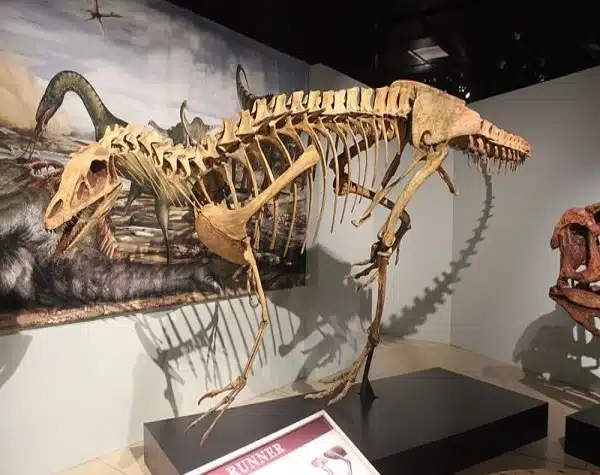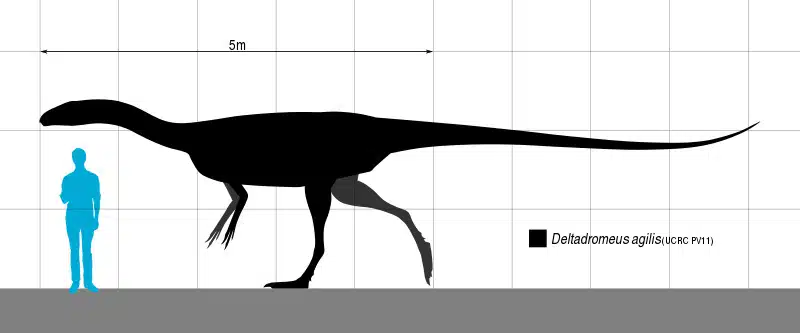Among the ancient giants of Nothern Africa was a fascinating dinosaur known as Deltadromeus. This enigmatic creature, whose name translates to “Delta Runner,” has captured the imagination of many. Discovered at first in the windswept sands of the Moroccan Sahara, Deltadromeus offers a unique glimpse into a world long gone.
Deltadromeus Key Facts
| Keyword | Fact |
|---|---|
| Pronunciation | del-ta-drome-ee-us |
| Meaning of name | Delta Runner |
| Group | Theropoda |
| Type Species | Deltadromeus agilis |
| Diet | Carnivore |
| When it Lived | 99.6 to 93.5 MYA |
| Period | Late Cretaceous |
| Epoch | Early/Lower Cenomanian |
| Length | Approximately 26.0 feet |
| Height | Approximately 7.0 feet |
| Weight | Approximately 1.2 tons |
| Mobility | Moved on two legs |
| First Discovery | 1995 by Gabrielle Lyon |
| Location of first find | Moroccan, Sahara |
| Also found in | Algeria and Egypt |
| First Described by | 1996 by Paul Sereno, Didier Dutheil, M. Larochene, Hans Larsson, Gabrielle Lyon, Paul Magwene, Christian Sidor, David Varricchio and Jeffrey Wilson |
| Holotype | SGM-Din 2 |
Deltadromeus Origins, Taxonomy and Timeline
Deltadromeus agilis, translating to “Agile Delta Runner” from Greek language, paints a picture of speed and agility. This carnivorous dinosaur, classified within the Noasauridae (Theropoda: Abelisauridoidae) lived during the Late Cretaceous Period, specifically in the Cenomanian Age, around 100.6 to 93.5 million years ago.

The Late Cretaceous Period, marked by a warm climate and diverse ecosystems, was the backdrop of Deltadromeus’ existence. Its era was a time of great diversity among dinosaurs, providing a vibrant setting for this intriguing creature.
Hear about the naming of Deltadromeus
Check out this fascinating short video where Gabrielle Lyon, who discovered the dinosaur, explains how it got its name.
Discovery & Fossil Evidence

The sands of time often conceal secrets, and in 1995, one such secret was unveiled by Gabrielle Lyon in the Kem Kem Beds of the Moroccan Sahara. This discovery marked the first encounter with Deltadromeus, a dinosaur that would intrigue scientists and enthusiasts alike. It was later published and named by Paul Sereno and colleagues in 1996.
Subsequent finds in Algeria and Egypt have added to our understanding of this dinosaur, with a total of six finds contributing to the fossil evidence. These discoveries have provided insights into the distribution and diversity of Deltadromeus.

The fossils of Deltadromeus, while not complete, have offered valuable information. The degree of preservation varies, but notable specimens, such as the holotype SGM-Din 2, have been instrumental in piecing together the puzzle of this dinosaur’s existence.
Deltadromeus Size and Description
Deltadromeus, was a remarkable dinosaur with a slender and streamlined build. Its body shape and structure were perfectly adapted for a carnivorous lifestyle. The absence of a known skull leaves some aspects of its appearance to the imagination, but its overall physique suggests a well-balanced predator.
This dinosaur was undoubtedly bipedal, moving gracefully on two legs. Its hind limbs were long and unusually slender for its size, hinting at a life spent swiftly chasing down prey. The tail, likely used for balance, complemented its agile form. While the details of its skin remain speculative, envisioning Deltadromeus as a sleek and efficient hunter isn’t a stretch.
Size and Weight of Type Species

The holotype of Deltadromeus agilis, cataloged as SGM-Din2, is a partial skeleton that paints a picture of a medium-sized theropod. This particular specimen is estimated to have measured around 26.0 feet in length. As for its weight, Deltadromeus tipped the scales at approximately 1.2 tons.
These dimensions, coupled with its long and slender hind limbs, strongly suggest that Deltadromeus was a swift runner. Its size and build would have made it a formidable presence in its natural habitat, capable of impressive bursts of speed. This combination of size, weight, and agility would have been key to its survival and success as a predator during the Late Cretaceous Period.
Interesting Points about Deltadromeus
- Deltadromeus’ name, meaning “Agile Delta Runner,” suggests it was one of the speedier dinosaurs of its time.
- Despite being a carnivore, Deltadromeus’ exact hunting strategies and diet remain a subject of intrigue and speculation.
- The distribution of its fossils across North Africa indicates a wide geographical range and adaptability.
- Deltadromeus’ classification within the Noasaurid family places it in a less commonly known but fascinating group of heropods.
- The discovery of Deltadromeus in the Moroccan Sahara highlights the region’s rich paleontological significance.
Deltadromeus in its Natural Habitat
Imagine the Late Cretaceous Sahara, a landscape vastly different from today’s arid desert. This was the realm of Deltadromeus, a world of diverse ecosystems, lush vegetation, and a warm climate. In this vibrant setting, Deltadromeus, a carnivorous predator, roamed in search of prey.
The diet of Deltadromeus, while carnivorous, is shrouded in mystery. Its teeth and jaw structure might provide clues, suggesting a diet that could include smaller dinosaurs or perhaps scavenging. As a bipedal dinosaur, its locomotion was likely efficient, aiding in both hunting and evasion.
Deltadromeus’ role in its ecosystem was undoubtedly significant. As a predator, it would have influenced the population dynamics of its prey, shaping the landscape indirectly. Its senses, while speculative, were likely keen, aiding in its survival in a world where every advantage counted.
Contemporary Dinosaurs

In the sweltering heart of ancient North Africa, the lithe and agile Deltadromeus navigated a world of giants and titans. Picture this: Deltadromeus, a sleek predator, darting through the underbrush, its slender frame dwarfed by the colossal creatures that shared its world. It was a realm where size often dictated survival, and our main dinosaur, though not the largest, was a master of agility and speed.
Imagine the tension in the air as Deltadromeus came face-to-face with the formidable Carcharodontosaurus. This massive predator, larger and more powerful, likely viewed our nimble friend as competition, or worse, as prey. Deltadromeus, however, wasn’t one to be easily cornered. It relied on its swift legs and keen senses to avoid direct confrontations with such behemoths. The dance between these two predators was one of respect and wariness, each understanding the other’s lethal capabilities.
Nearby was the Spinosaurus. This behemoth, larger than both Deltadromeus and Carcharodontosaurus, would however not been in competition with them. Spinosaurus likely had a fish based diet and was possibly semi-aquatic. Their interactions, though not direct, were a testament to the complex web of relationships in this ancient ecosystem.
Then there were the gentle giants, the Aegyptosaurus and Paralititan, towering and peaceful herbivores that roamed in herds. To Deltadromeus, these behemoths were neither competitors nor threats but potential prey. The size difference was stark, with our main dinosaur being significantly smaller, but what Deltadromeus lacked in size, it made up for in cunning and speed.
Frequently Asked Questions
It was discovered in 1995 by Gabrielle Lyon.
Its name means “Agile Delta Runner.”
It was first found in the Moroccan Sahara, in the Kem Kem Beds.
It is a theropod, specifically a noasaurid.
It was a carnivore, though its exact diet is not fully known.
It moved on two legs and was likely quite agile.
Sources
The information in this article is based on various sources, drawing on scientific research, fossil evidence, and expert analysis. The aim is to provide a comprehensive and accurate overview of Deltadromeus. However, please be aware that our understanding of dinosaurs and their world is constantly evolving as new discoveries are made.
- https://www.jstor.org/stable/2889583
- https://www.researchgate.net/publication/304013683_NEW_THEROPOD_FAUNA_FROM_THE_UPPER_CRETACEOUS_HUINCUL_FORMATION_OF_NORTHWESTERN_PATAGONIA_ARGENTINA
- https://journals.plos.org/plosone/article?id=info%3Adoi/10.1371/journal.pone.0157793
- https://royalsocietypublishing.org/doi/epdf/10.1098/rsos.220106
This article was last fact-checked: Joey Arboleda, 11-04-2023
Featured Image Credit: Ornitholestes, Public domain, via Wikimedia Commons

